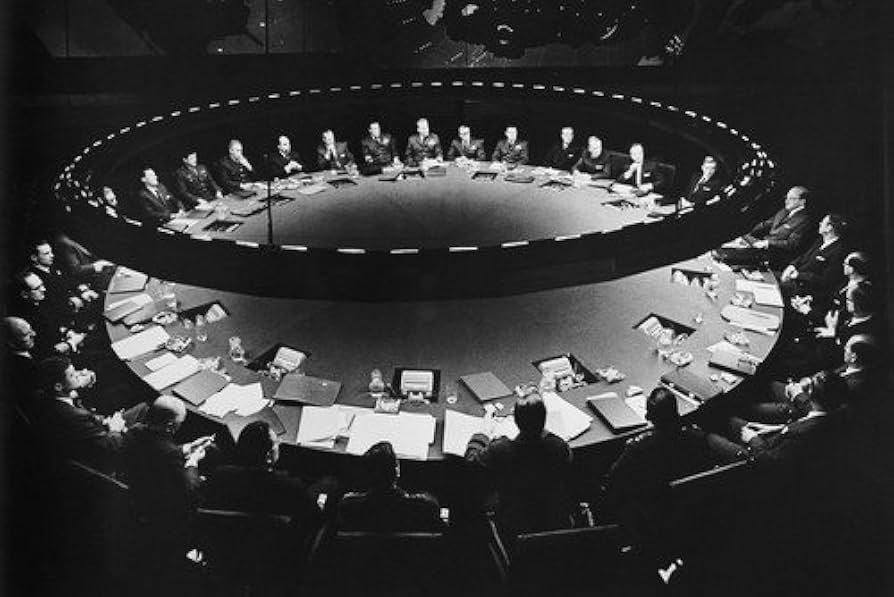Dr. Strangelove: How I Learned to Stop Worrying and Love the Bomb is a political satire film by Stanley Kubrick from 1964. In this black comedy where Kubrick deals with a completely fantasy subject, he shows that the processes experienced when there is an existential threat are very similar to each other. In this classic where Peter Sellers plays three different roles, it is told how the world is dragged into a nuclear war after a series of wrong decisions.
Although the subject of the film is completely different, the crisis process mentioned bears striking similarities to the process experienced in the waste crisis that occurs when the 2.1 billion tons of waste produced in the world every year increase.
Abort the Mission
The events in the film begin with a paranoid American Air Force general ordering a nuclear attack on the Soviet Union with the absurd excuse that they are “trying to steal Americans’ valuable bodily fluids.” In the following minutes, the scenes continue with a series of events where the US president and his advisors try to call off the bombers.
These sequences, in addition to drawing attention to the lateness, short-sighted policies and lack of control, bear a great resemblance to the point reached in the waste problem, another existential crisis in the world. The idea that waste will disappear by being removed from sight, such as burying and burning, has unfortunately made this situation worse today. As an example of this issue, in 2016, a study conducted by a Turkish team in Antarctica to investigate the effects of chemicals related to industrialization on living conditions on the continent found agricultural and pesticides on the continent. These drugs, which were used in agricultural areas between 1940 and 1970, were later banned, but it was too late.
Although a long time has passed since the ban, in 2016, they were carried to a continent where no agriculture had been done before, as a result of atmospheric movements, and began to negatively affect life on the continent. In addition, the fact that microplastics were found on the summit of Mount Fuji and in the blood of newborn babies shows us that, just like in the movie, we do not fully understand and cannot control the consequences of our actions.
The Doomsday Machine
One of the main events in the film is the discovery of the existence of the Soviet “Doomsday Machine”. This doomsday machine was designed to automatically respond with a larger nuclear attack in the event of a possible nuclear attack. Although it was designed as a deterrent, this machine accelerates the apocalypse instead of preventing it.
Similarly, many approaches we offer as solutions to waste problems have created different problems instead of preventing it. Although recycling programs are perceived as environmentally friendly at first glance, they often miss their purpose and offer no other solution than transferring the waste at hand. An example of this is the export of technological waste by developed countries to developing countries, and instead of finding a solution to the problem, they simply relocate the waste.
Waste incineration plants are also structures that resemble doomsday machines. Although these facilities, which are not adequately inspected, reduce solid waste, they also release harmful pollutants into the air, causing more harm to the environment. Even after the laws passed to prevent air pollution, approximately 250,000 people die each year in the United States and 3 million people in China and India due to air pollution-related diseases.
Mine Shaft
In another important scene in the film, the Dr. Strangelove character played by Peter Sellers suggests that all humans should live in a deep mine shaft as a solution to the salvation of humanity and that each man should have sex with 10 women in order to increase the population rapidly. This suggestion is not only extremely absurd, but also an indication of how helpless humanity is in such crisis processes. Although such suggestions are presented as a comedy element in such films, they have sometimes been put forward for the waste crisis in the world we live in, and because they are not realistic and applicable, they have worsened the situation rather than solved the existing problem.
The idea of sending radioactive waste into space, which is currently being discussed, is one of the absurd solutions suggested for the waste crisis, just like the mine shaft idea in the film. These types of solutions offer temporary and costly solutions instead of addressing the root causes of the problem. Sending radioactive waste into space is both costly and environmentally unsustainable.

No Fighting in the War Room!
Humanity’s efforts to cope with the dangers it has created throughout history have unfortunately often been inadequate due to lack of foresight and inability to find sustainable solutions. Addressing the crises in both situations we mentioned requires a rational approach, not only reviewing existing solutions, but also getting to the root of the crisis and finding permanent solutions. This is the exact opposite of the Dr. Strangelove mentality.
For a sustainable future, individuals, societies and governments need to cooperate and take steps to reduce waste production and eliminate environmental injustices. Only in this way can we solve the waste problem, one of the greatest crises humanity has ever faced, and stop the fight in the War Room.







